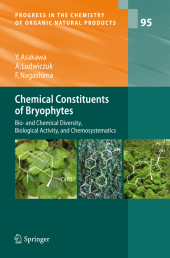 Neuerscheinungen 2012Stand: 2020-01-07 |
Schnellsuche
ISBN/Stichwort/Autor
|
Herderstraße 10
10625 Berlin
Tel.: 030 315 714 16
Fax 030 315 714 14
info@buchspektrum.de |

Yoshinori Asakawa, Heinz Falk, A. Douglas Kinghorn, Junichi Kobayashi, Agnieszka Ludwiczuk, Fumihiro Nagashima
(Beteiligte)
Chemical Constituents of Bryophytes
Bio- and Chemical Diversity, Biological Activity, and Chemosystematics
Ed. by Kinghorn, A. Douglas; Falk, Heinz; Kobayashi, Junichi
2012. xviii, 796 S. 208 SW-Abb., 42 Farbabb. 243 mm
Verlag/Jahr: SPRINGER, WIEN 2012
ISBN: 3-7091-1083-1 (3709110831)
Neue ISBN: 978-3-7091-1083-6 (9783709110836)
Preis und Lieferzeit: Bitte klicken
For some 50 years, Professor Asakawa and his group have focused their research on the chemical constituents of bryophytes and have found that these plants contain large numbers of secondary metabolites, such as terpenoids, acetogenins, and aromatic compounds representative of many new skeletons, which exhibit interesting biological activities. Individual terpenoids, when found as constituents of both a bryophyte and a higher plant, tend to occur in different enantiomeric forms. Professor Asakawa has covered the literature on bryophytes in two earlier volumes of Progress in the Chemistry of Organic Natural Products , namely, Volumes 42 (1982) and 65 (1995). Since the publication of the latter volume, a great deal of new information has appeared on bryophytes. One example is that known sex pheromones of algae have been discovered in two liverworts, indicating that some members of the latter taxonomic group might originate from brown algae. From information provided in this volume, it is suggested that two orders of the Marchantiophyta should be combined.
Introduction.- 1 Biodiversity of Bryophytes.- 2 Chemical Diversity of Bryophytes.- Typical Components of Bryophytes.- Chirality of Terpenoids from the Marchantiophyta.- Essential Oils of some Marchantiophyta Species.- Chemical Constituents of in vitro Cultured Cells and Field Gametophytes of some Marchantiophyta Species.- 3 Chemical Constituents of the Marchantiophyta.- Monoterpenoids.- Sesquiterpenoids.- Diterpenoids.- Steroids and Triterpenoids.- Aromatic compounds.- Flavonoids.- Acetogenins and Lipids.- Miscellaneous.- 4 Chemical Constituents of Anthocerotophyta.- Terpenoids.- Steroids and Triterpenoids.- Aromatic Compounds.- Flavonoids.- Acetogenins and Lipids.- 5 Chemical Constituents of Anthocerotophyta.- Terpenoids.- Sterols.- Aromatic Compounds.- Lipids.- Miscellaneous.- 6 Biologically Active Compounds of the Marchantiophyta and Bryophyta.- Fragrance.- Pungency and Bitterness.- Allergenic Contact Dermatitis.- Antibacterial, Antifungal, and Antiviral Activity.- Insect Antifeedant Activity.- Antioxidant Activity.- Antithrombin Activity.- Brine Shrimp Lethality Activity.- Calcium Inhibitory Activity.- Cathepsin B and L Inhibitory Activity.- Cytotoxic and Apoptotic Activity.- Farnesoid X-receptor (FXR) Receptor Activation.- Alpha-Glucosidase Inhibitory Activity.- Insecticidal Activity.- Liver X Receptor Alpha Agonist Activity.- Muscle Relaxant Activity.- Nematode Larval Motility Inhibition Activity.- Neuroprotective Activity.- Nitric Oxide Production Inhibition.- Plant Growth Inhibitory Activity.- Piscicidal Activity.- Tublin Polymerization Inhibition.- Vasorelaxation.- 7 Chemosystematics of the Marchantiophyta.- Chemosystematics of Haplomitriopsida.- Chemosystematics of Marchantiopsida.- Chemosystematics of Jungermanniopsida.- Conclusion.- Chemical Relationships Between Algae, Bryophytes, and Pteridophytes.- Similarities Between Liverworts, Mosses, and Hornworts.- Similarities Between Algae and Bryophytes.- Similarities Between Bryophytes and Pteridophytes.-


